All about weaving from a vine

Wicker weaving is a kind of alternative to rattan, which is now fashionable. Baskets, lampshades, boxes, boxes, wreaths, vases and chests made of vines will perfectly fit into eco-style, eco-boho, the most modern and popular trends. Therefore, it is fashionable to do basket weaving again.


Peculiarities
The oldest baskets, woven from willow twigs, date back to pre-Christ times. Wickerwork as artifacts was found in various parts of the world, which indicates the demand for this craft, its development.


10 interesting theses about basket weaving.
- Weaving from a willow twig is the most direct way to get beautiful baskets and vases. But you can also use a nut twig, it bends just as well and is durable. Flexible species of shrubs and trees, in principle, are suitable for weaving, do not be afraid of experiments.
- You can use unbarked material, that is, not peeled from bark, but peeled material is well used. Baskets for mushrooms and vegetables, wattle are often weaved from the unrooted one. The barked one goes to more elegant things.
- In the summer, weaving rods are not harvested. The rapid growth of the tree makes the branches brittle. Therefore, a willow or other plant is harvested in spring or autumn. In winter, theoretically, this can also be done, but it is not always convenient to get to the tree through the snowdrifts. Before cutting the branch, it is tested for flexibility - it is twisted around the finger.
- If a person has already practiced weaving on newspaper tubes, their hands and brain are ready to cope with the more finicky willow - in fact, "newspaper preparation" really serves as a good warm-up.
- The most popular vine crops are willow, white willow or silver willow. This tree grows not far from ponds and rivers, however, and along the roads too. Willow leaves are covered with white-silvery hairs.
- Suitable for weaving and willow, growing bush or small tree. Has young yellow or olive brown bark.
- The harvested rods are dried on a wooden flooring, the vine is laid out in a thin layer. In the heat, the branches should be under a canopy, otherwise they may crack.
- In a dry room, willow bundles can be stored for 3-4 years. Raw materials are afraid of moisture and frost, this should be remembered by the craftsman during periods of risky weather.
- Humanity has come up with many types of weaving. First, the simplest is mastered, gradually the complexity of weaving goes up.
- The most popular vine craft is still the basket. This Russian interior item is used in a new way in a modern home: not only berries are stored in a basket, for example, but also used as a stand for cooks, as a basket for books, as a container for storing paper bags with self-collected tea, etc.
If the vine is already there, and is ready to fall into the hands of the future master, it's time to start studying.
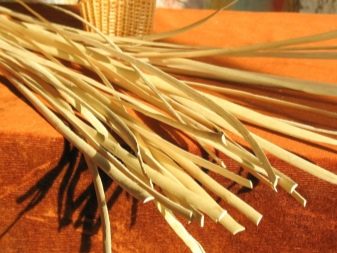

Species overview
Techniques are mastered one by one, without working out the previous one it is not worth moving on to the next.
Direct
In this weaving, one rod is used. The uprights should be skirted one by one, one behind and the other in front, and so on until the end of the rod. The next rod will be docked with the previous one. When joining thin ends, both the old and the new are involved in weaving, simultaneously going between the three risers. Simple weaving in a closed loop involves an odd number of risers. On one circle, the riser is braided from the outside, on the next - from the inside.
Simple weaving is good for decorating bottles and vases.

In rows
Also applies to simple weaving, the main thing is to pick up rods of approximately the same thickness. Their length in this case will not matter. It is produced with two rods at once: it starts from the butt ends of the shortest elements. By simple weaving, they are braided through one rack to the end of the element, thin fragments remain out of work.
The butt part of the second rod is laid behind the next rack and then a simple scheme follows.
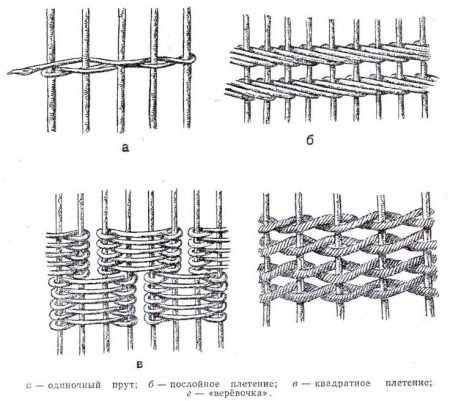
Square
It involves weaving with one or two paired branches, you can also use a willow tape (this is a different level of complexity). The main thing is that the weaving goes through two racks. The square method can be two-variant: chess and checkers. Checker is a simple option through two racks, chess is more difficult. The first element will first outwardly overtake the first or second posts, then bend inward between the second and third posts, overtake the third and fourth, and already between the fourth and fifth rods will come out.

Rope
In other words, the technology is called twisting. It is used when you need to give the product greater strength. A single rod is used, but in the process of weaving, at least two of them are still involved. The rods of the rack will intertwine with each other, which will give strength.

Openwork
This is a variation on the same string. Usually it is done in two branches, which should be the same in thickness and strength. The rod is bent in half, bends around the first stance with its butt end inward, and goes out with its apical end. The apex tip goes behind the butt lining, bends between the first and second posts inside the craft, bends around every second post inside and is brought out between the second and third.
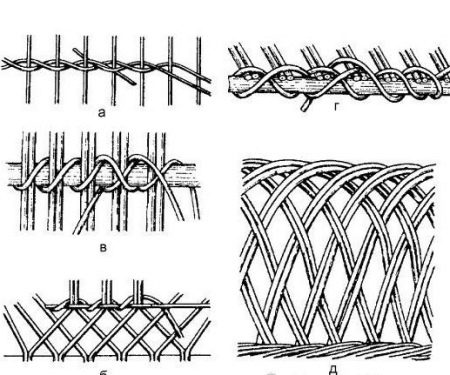
Diamond-shaped
Very interesting schemes are presented in this technique. It is necessary to combine rods and ribbons. If the warp and weft are different in color, it turns out especially beautifully. Weaving traditionally begins in the middle, then leads in different directions. In order for all sides of the rhombus to be perfectly even, the number of weft and warp twigs must match.

Material preparation
All techniques and methods are comprehended in practice, experience is the best teacher. But each student goes through the stages of preparing the material, knowing how to handle it, searching for quality tools (this is very important), choosing an object that will grow out of willow twigs, and, finally, making it.
This path, albeit at first in theory, can be walked together.
The masters call the beginning of weaving exactly the blank of the material. This work is as difficult physically as it is interesting.

Here's what it includes.
- Collecting vines in a favorable period. It is ideal to do this while walking. After that, the material is sent to drying. The pre-cut rods must be peeled and chopped within two, maximum three hours. This is basically done before drying.
- If the rods are stored outdoors in winter, then they can be peeled from the bark and boiled as needed. The bundle brought into a warm room should thaw out. As soon as they leave, they are sent to the boil, and then the bark is removed from them.
- Boiling for two hours will give the material a dark, rich shade. It takes at least 40, but not more than 60 minutes for the vine to become light beige, not without a golden undertone. It will get dark for the next six months.



If you do not boil the vine, then it must be soaked. This will take about 2 weeks. Water must be added in descending order. If after this period the bark comes off well from the rod, you can safely remove it. If not, soak continues. If the bark cannot be prepared for removal in any way, you need to take it as it is.
For a basket, such material is ideal, for example.

What tools are needed?
Of course, each master has his own tricks, how and when to collect the vine, how to prepare it ideally and how to process it later. But you can guess what a universal list of instruments looks like.
- Crusher. It is very convenient to use it to separate the bark from the twig. A strong metal crusher is made from steel wire 10 or 15 mm in diameter. And a simple wooden structure can be created by yourself, taking, for example, a willow stick 40 cm long and 3 cm thick.
- Splitters. Very cleverly, they split the rods into several parts. They are made of hard wood, the back end of the tool should be convex, and on the other - 3-4 incisors.
- The chauffeur. Refers to planing tools and is necessary for the formation of planed belts. It is fixed on the table very firmly.
- Shmol. It is needed to plan the width of willow ribbons.
- Zhamki. Can straighten and bend rods. At one end of the device, a ring is made with a cutout, a rod is put into the cutout, which is to be changed.
- Knives. Gorbach carefully cuts the ends of the willow, the basket knife is more utilitarian - they can not only cut the ends, but also get rid of knots, cut something.
- Pruner. The most common, garden one, it will be the main tool.
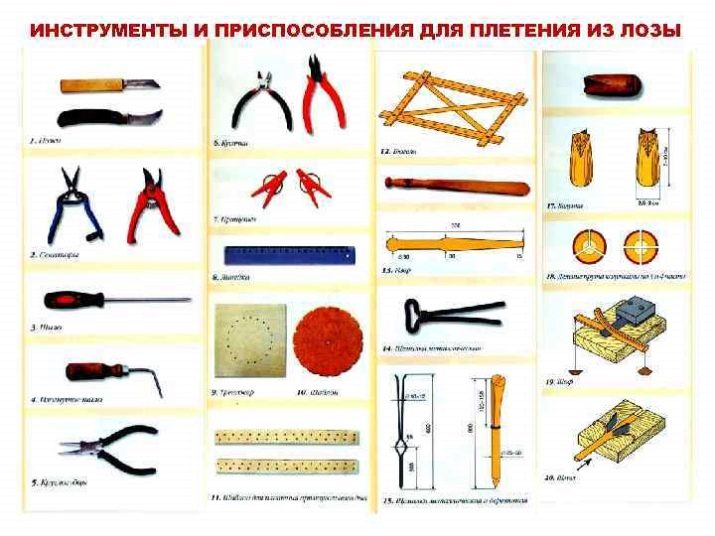
And in the work you will need hammers, pliers and round-nose pliers, as well as an izer that seals the walls of large crafts. Clips, awls and templates will probably be required. But it doesn't make sense to buy everything right away, although if you want to buy a set, there are some on sale.
You can go to online stores.
And, of course, the master will need a desk that is well lit and at which a person is comfortable to sit. It is good if there are tool boxes in the table. Probably, a drill with a set of drills (to make holes in the templates), and hacksaws, and screwdrivers, and screws, and various wires would be useful. The master makes many devices, adapts, as they say, "for himself." Here, an individual approach also works, and not a rigid regulation.

What can be done?
With the help of techniques of various degrees of complexity, using techniques such as false braids and knotting, using dyes for willow, people make things of amazing beauty and ways of using. Even a sculpture worthy of a museum display can be made from a vine.
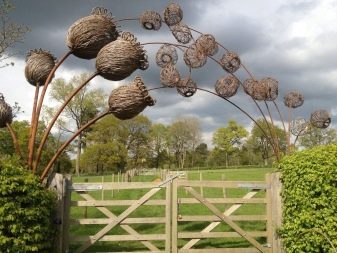

Here's what interesting basket weaving has to offer.
- For the garden and vegetable garden. Baskets that replace flower pots. If they stand under a canopy, under a roof or a canopy, they are definitely not in danger. And they are good in that they add lightness, airiness, romance to the site. You can weave a decorative nest for fantasy birds out of plywood, for example. You can make a wreath on the front door that will hang in any season.



- For home. Luxurious, in a perfect country style, they weave lampshades from a vine. These patterns, together with the play of light, create unique combinations that emanate from comfort and some kind of nostalgic simplicity of hand-made things. Such lampshades are conducive to communication, tea drinking, reading, board games. Vine flower pots, original dream catchers, openwork trays, and charming bread bins are used for home decor.





- Chairs and tables. If the vine becomes a material for creating furniture, this indicates a high skill of the artisan. Some things will have a plywood bottom, that is, they will be strengthened, which is quite normal. For large products, selected varieties are harvested, the rods are carefully prepared for processing.


But they start, as already noted, with universal things - baskets and baskets.

How to weave a basket?
For this work you will definitely need:
- secateurs or knife;
- side cutters;
- awl;
- a spray bottle (to moisten the rods during the weaving process).

Master class for beginners - basket step by step.
- At the beginning of the process, you need to split five whole, sufficiently long branches. 5 more branches are carefully inserted into the split layers. And then into the same holes - the tips of the first two.

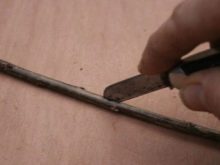
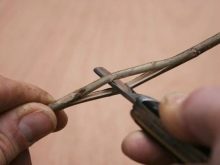
- Now you can start braiding the bottom. The first twig is taken, it covers the split branches from above, and using the second twig, the remaining ones are covered below. With the third and fourth vines, everything is done as it was done before.

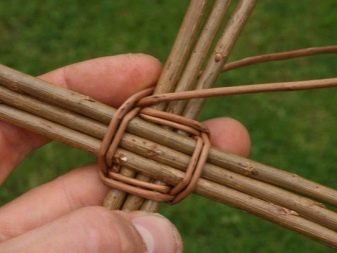


- Cross rods expandto make it look like a fan, they are entwined with two rods.

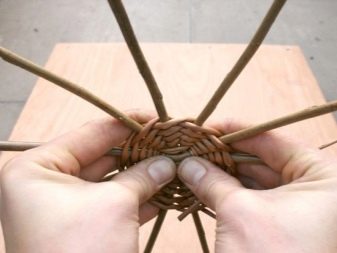
- The braided twigs are pressed against each other. A tailor's awl will help to cope with this.



- When the bottom is ready, you need to install the edges of the basket. A round willow tree is taken, its ends are cut obliquely, but at a distance of 5 cm. Then the sharp ends are inserted into the braid of the bottom, and everything unnecessary, of course, is cut off.


- The bottom edges are made of four round willow branches, which are inserted 4 cm from the side ribs. The basket must be given a round shape, small carnations must be driven into the bottom. This is all done to strengthen the product.

- It's time to move on to the braiding of the sides. And again the ends of the twigs are cut off, only the branches are needed already of medium size. A new vine is inserted along each twig.



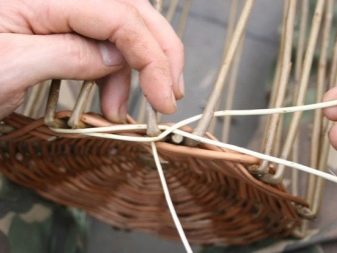
- Next, the new vine is bent exactly under two adjacent vines: first to the left, then down, then up.
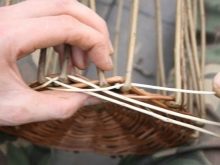


- The rest of the material is the same. But the last two twigs are corny twisted around the first twig. And weaving lasts to the limit until the craft becomes optimal in height.


- The basket needs handles, for which a thick willow tree is good. Such massive branches are bent, the desired length is determined, the excess is cut off. And again the tips should be sharpened by inserting them into the walls of the basket. At the base of the handle, 5 rods are placed with which this handle will be wrapped. All willow excess must be cut off and hidden behind the walls.

This master class is really not so difficult to repeat with your own hands. There are no complicated patterns here, everything is simple and predictable, which is what you need for your first job.
Caring for crafts
Wicker products, to the delight of their owners, are not capricious. They can be easily washed with warm water, you can use soap or liquid products. Wicker vases and boxes, of course, should not be soaked and poured with boiling water. If the product is not painted, disinfection with a special solution is not prohibited.

Care rules:
- wiping with a dry or damp, lint-free cloth is an ideal condition that will help preserve the beauty of the product as long as possible and prevent it from becoming dusty;
- if, for example, stains appear on the basket, you cannot do with one cloth - the detergent combines with salt, and you need to rub the dirt with this mixture with the help of a sponge;
- abrasive substances are not used for cleaning - they can damage the willow tree, irreversible scratches will remain on it;
- vine products do not like dry air and high temperatures, therefore, the main principle of care will be to maintain a comfortable microclimate in the house;
- if a dent appears on the basket, you can try to fix it like this: soak this place and try to bend it, give the product its initial shape by hand;
- on baskets or chests, vases, pots that need restoration, you can apply a thin layer of linseed oil, after which the product is covered with colorless varnish;
- to change the shade of the product, a stain is used for toning, the vine "gets along well" with it;
- if a willow product is on the street, soil can become a dangerous abrasive for it (under certain circumstances), therefore, before washing the product, you need to free it from the ground.

How to weave a round willow basket, see the video below.


